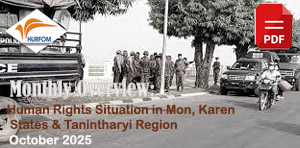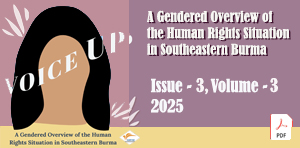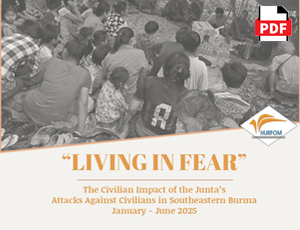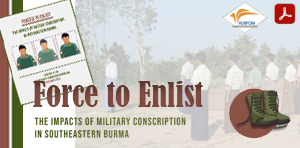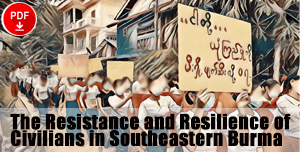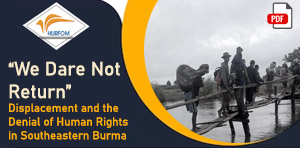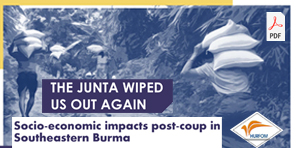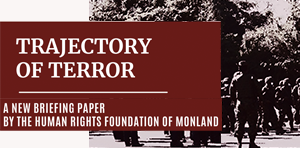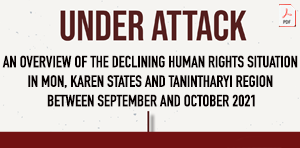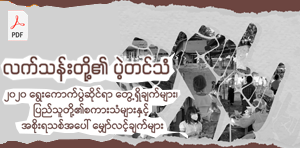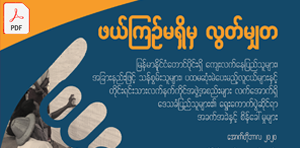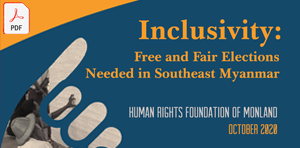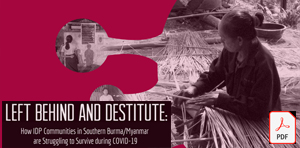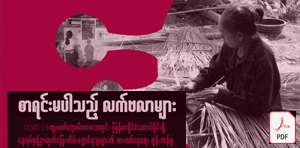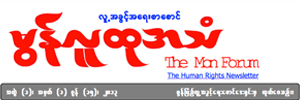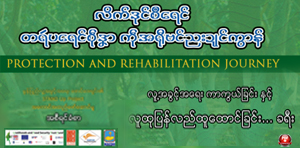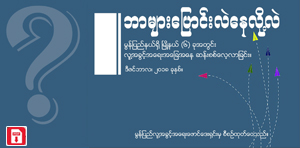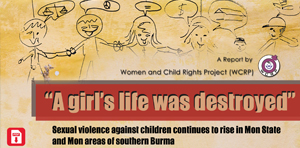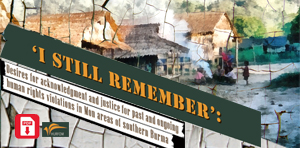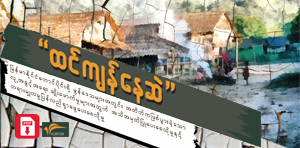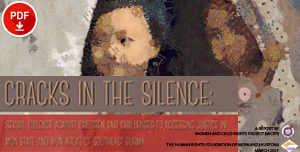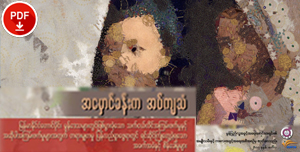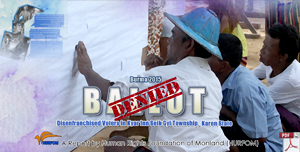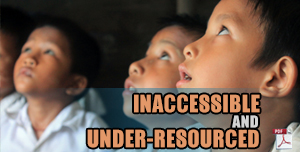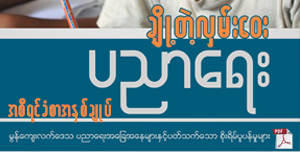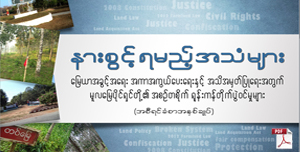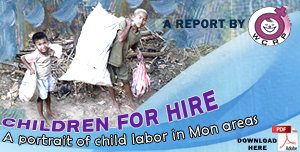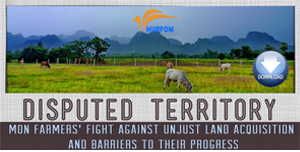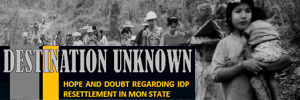Voice Up: A Gendered Overview of the Human Rights Situation in Southeastern Burma
July 11, 2025
Issue 2, Volume 2 | 2025, April – June 2025
Introduction
This report is the second issue of a year-long series of quarterly updates and analyses, combining data collected from the ground by the Women and Children’s Rights Project of the Human Rights Foundation of Monland (HURFOM). Last year, HURFOM released four versions of Voice Up, which were also released quarterly.
Before the attempted coup in Burma on 1 February 2021, HURFOM published similar content in a bulletin-style format under the title ‘Voice Up.’ The Women and Children’s Rights project is of utmost importance as it seeks to monitor the situation of women and children in Mon areas and southern Burma and how it relates to the UN Convention on the Elimination of All Forms of Discrimination Against Women (CEDAW) and the UN Convention on the Rights of the Child (CRC). Field staff collect and distribute information and data to our local and international networks.
The findings empower and educate women and children in the Mon community by providing information on their rights, as outlined in the Convention on the Elimination of All Forms of Discrimination Against Women (CEDAW) and the Convention on the Rights of the Child (CRC), and encourage them to participate in the struggle to protect and enforce their fundamental freedoms.
Activities under the project include:
- A bi-annual Mon and Burmese-language journal titled: Our Rights Journal;
- Capacity building, which provides for training in women’s and children’s rights and training trainers in both areas;
- Data collection and documentation on topics such as the trafficking of women and children and violence against women and child soldiers.
The cases of human rights violations perpetrated against women presented in this briefing paper are indicative of decades of military impunity. Despite their many challenges, this report is a testament to the dedication and perseverance of the women human rights defenders (WHRDs) leading the documentation efforts.
Situation Overview for Women in Burma: April – June
The rights of civilians throughout the country have been consistently under attack for decades in Burma, particularly in rural areas where ethnic groups have long faced persecution by the junta forces. Since the failed coup, these conditions have worsened significantly as the borderlands have become battlegrounds. The current challenges faced by women primarily involve safety and security, especially as the Burma Army continues to perpetrate human rights violations, including conflict-related sexual violence, with impunity.
Women and children, who make up the majority of those displaced in Burma, have suffered immensely, as access to healthcare, justice, education, and livelihoods has been severely compromised by the regime’s presence, including the frequent occurrence of airstrikes and ground attacks.
Violence against women occurs in both private and public spaces, putting the lives of female detainees in military custody at higher risk. A lack of accountability for these crimes is systematically entrenched, forcing women to live with their trauma and carry on without adequate justice, accountability, counselling, or resources. Today, nothing stops the junta from recommitting these horrendous crimes. Gender-specific violence poses a serious threat to WHRDs on the ground.
The human rights crisis in Burma impacts individuals differently based on gender, age, and social roles. Women and girls, particularly in conflict-affected regions, face increased risks of gender-based violence (GBV), including sexual violence, displacement, and forced labour. Female human rights defenders (HRDs) encounter threats, harassment, and limited access to security resources. Men and boys are more likely to be forcibly conscripted into the military junta or arbitrarily detained. Women, in particular, have faced worsening gendered consequences of the conflict. The Women’s League of Burma reported nearly 500 cases of sexual assault between February 2021 and June 2024, with at least a dozen resulting in women being raped and killed.
In addition, LGBTQ2I individuals experience discrimination, violence, and legal barriers when seeking justice. The project addresses these disparities by integrating gender-sensitive human rights documentation, ensuring equal participation in training and leadership programs, and providing tailored psychosocial and emergency support to meet diverse needs.
Politics in Burma is shaped by patriarchy. Long-held customary and social norms regarding perceptions of decency, as well as the protection of purity and virginity, have attempted to restrict women’s mobility and confine them to the home. This has entrenched systems in which women, particularly ethnic women, hold few positions of power and entry into the political domain is strongly discouraged by powerful men.
Nevertheless, WHRDs in Burma are at the forefront of the country’s long-standing struggle against the military junta. They have shown unwavering dedication to ending the junta’s suppression of rights and freedoms. Additionally, they have tirelessly advocated for change in Burma’s authoritarian trajectory, making significant strides toward achieving gender equality.
Throughout the second quarter of the year, the Human Rights Foundation of Monland (HURFOM) continued to monitor and evaluate the total erosion of fundamental freedoms and protections, especially for women who lack reliable access to legal systems that would hold the junta accountable for the widespread and indiscriminate attacks. Documentation by HURFOM indicated that the regime is increasing its attacks in civilian areas, particularly in locations that women and children frequent. The majority of the assaults that took place happened without any active conflict or armed opposition actors in the vicinity.
The military junta actively targets individuals, including human rights defenders, women human rights defenders, and leaders of various pro-democracy groups, particularly since 2021, which includes the Civil Disobedience Movement (CDM). Women-led organizations frequently face reprisals for their advocacy and speaking out on behalf of their communities, calling for urgent action and attention from the international community to hold the regime accountable.
No revolutionary period in Burma has ever occurred without the participation and leadership of women. Indeed, their contributions sustain it. Despite being countless victims of the junta’s atrocities, women have not lost their agency or their commitment to upholding and protecting human rights. They are becoming increasingly bold in their advocacy and calls for the regime to be held accountable. HURFOM has been a vocal proponent of ensuring that women are viewed in a highly esteemed regard for their immense sacrifice and contributions to the People’s Movement.
Findings from this second quarter revealed that between April and June 2025, in the HURFOM targeted areas of Mon State, Karen State, and the Tanintharyi Region, 22 women were killed, 80 injured, and 42 arbitrarily arrested. There were also 23 children killed and 32 wounded. Since the unlawful coup, HURFOM has reported that the total number of women casualties is 225, 495 wounded, and 260 arbitrarily arrested and detained. In addition, 75 children have been murdered by the junta and 137 have been injured.
Serious concerns remain regarding the protection of women, given the grim realities they are facing on the ground. Uncertainties persist, significantly undermining communities’ ability to rebuild following the coup’s devastation. The earthquake on March 28th further obstructed access to life-saving emergency aid, especially as the junta once again impeded access by exploiting the crisis for their own benefit. The regime deliberately dictated which country-wide relief teams could operate, prioritizing countries such as China and India. The media faced heavy restrictions in covering the damage and were required to seek permission from the junta, resulting in delays.
HURFOM documentation shows a consistent trend: the junta is increasingly targeting civilian areas with airstrikes and shelling, notably in resistance-held or contested zones. These operations have led to the destruction of homes, religious buildings, and farmland and continue to cause injuries and deaths among civilians. Extortion at military checkpoints and supply restrictions along main roads have worsened the humanitarian crisis.
Almost daily aerial attacks by the military junta continue to threaten and terrorize civilians across southern Burma, significantly disrupting livelihoods and creating immense anxiety over safety and security. Analysts suggest these intensified airstrikes aim to reclaim control and suppress local support for resistance movements following heavy losses of ground troops in southern and southeastern Burma.
Women and children, in particular, face different challenges during natural disasters. Therefore, a gendered response to the crisis is crucial, as their vulnerabilities are exacerbated by the impacts often linked to climate change. These effects include rising temperatures and air pollution, which affect women’s health and can result in preterm births, low birth weight, and diminished maternal health.
Several organizations issued an urgent appeal for a localized response to the earthquake, expressing clear concerns for women, children, individuals with disabilities, the elderly, and those in prisons. They stated, “Aid efforts must prioritize gender-sensitive support by ensuring access to menstrual aid, safe shelters, and medical care for women, including pregnant women, new mothers, and infants.”
According to HURFOM’s documentation, the junta launched 244 airstrikes throughout April alone. These killed at least 201 civilians and injured more than 300 others. Despite the claimed ceasefire, the conflict has only intensified in May, especially in southern Burma, fueling new waves of displacement. The displaced communities of Dawei, Mon, and Karen continue to bear the brunt of the consequences. Already traumatized by airstrikes and forced to flee, they now face hunger, sickness, and fear with little to no support.
Amid the catastrophe, the military junta declared a ceasefire extended to May 31st. Yet, it was repeatedly violated, including an airstrike on a school in the Sagaing region, which killed at least 20 children and two teachers on May 12. Less than one week later, a grade-6 boy, a grade-12 girl, and two women lost their lives when a junta aircraft dropped three bombs during an unprovoked attack on Nwe Ein village in Pale Township, Sagaing Region, on Sunday. Six others sustained injuries.
During the alleged ‘ceasefire’ period, the junta also dropped a 500-pound bomb on Rathedaung Township, Rakhine State, where 13 people died, including young children and 20 others were injured. In target areas of HURFOM, the junta’s violence also continued after the earthquake, worsening the challenges and compromising the ongoing relief effort to support the most vulnerable.
HURFOM reported that less than 48 hours after the earthquake, on the night of March 29, at 10:45 PM, junta forces launched indiscriminate artillery shelling from Waw Township, Lat Pan village in Bago Region, near the Mon State border, across the Sittaung River. The shells struck Khaywe village in Monsu Ward, Kyaik Hto Township, Mon State— areas already suffering from the aftermath of the recent earthquake. Despite this, the junta showed no regard for humanitarian principles and deliberately fired heavy artillery at civilian areas.
Two elderly civilians were injured in the attack: U Kappali (72 years old) and Daw Kyun, his wife. The couple sustained injuries when a shell landed near their home, with U Kappali suffering severe wounds to his right arm, which required 16 stitches. The shells were fired from Lat Pan village using 81 mm artillery. This incident is a heartbreaking reminder that even in the wake of a natural disaster, the junta continues to disregard civilian safety and international humanitarian law.
Women are still suffering the aftermath of the conflict, facing health and safety threats not just from the Burmese Army but also from ongoing gender-based violence and discrimination. In rural villages, women who attempt to flee from the junta are often sexually abused while in military custody. A defining feature of these offensives is the ongoing use of sexual violence against women, which qualifies as crimes against humanity according to international human rights law. The trauma and lack of reliable and accessible pathways often hinder the interest, motivation or capacity to participate in civil society forums.
Historically, the military has sought to marginalize women’s and girls’ involvement, yet countless sacrifices have been made to prevent their victory. Women have demonstrated relentless determination and courage, openly challenging power structures and striving to dismantle military rule and patriarchal systems.
The discriminatory nature of the gendered assaults on women’s rights is evident in the way junta-backed troops treat women. On June 17th, HURFOM reported on a case where a woman from Mudon Town, Mon State, was returning from a shopping trip when she was stopped by a joint traffic team conducting a check for unlicensed vehicles. She encountered the traffic police and was fined because she wasn’t wearing a bra.
Further, the situation on the ground remains immensely concerning, as there are ongoing delays in responding to the atrocities being perpetrated by the junta in Burma. Compounding the already challenging circumstances are the funding cuts by USAID, which have led to joint appeals by civil society organizations urging for more funds, as communities affected by the junta’s violence are on the brink of starvation if their most basic needs are not met.
Over the past few months, airstrikes and artillery shelling have displaced thousands, leaving families to shelter in jungles or makeshift huts without access to food, clean water, or healthcare. Regional administrators and local leaders urge civilians to remain vigilant. Despite repeated calls for international condemnation, the junta’s violence continues unabated. The growing military presence and widespread fear of human rights abuses have driven communities into renewed cycles of displacement.
According to data gathered by HURFOM and partner networks, junta troops stationed in the area have launched at least five rounds of shelling per day despite no ongoing clashes in many locations. This tactic has caused fear, injury, and further displacement, especially among women, children, and the elderly. Nearly 1,000 civilians from other areas of Kyaikhto, Mon State, have also fled towards Theinzayat town. Locals report that many are struggling with severe shortages of food and medicine. The crisis remains dire, with ongoing insecurity and no signs of military de-escalation.
More than 80 percent of those displaced in Burma are women and children. Those displaced are suffering from chronic illnesses as a result of a lack of access to clean drinking water. As they flee, they’re robbed of basic access to clean drinking water and food in their villages. They’ve also been forced to put their education and livelihoods on hold indefinitely. Hundreds of thousands of civilians risk starvation as formal channels of humanitarian aid have been blocked by the military. Thomas Andrews, the United Nations Special Rapporteur on Human Rights in Myanmar, has previously warned of mass starvation and disease in the region.
Throughout May alone, HURFOM has confirmed over 110 artillery and air attacks, resulting in at least 25 civilian deaths and dozens more injured, including children, women, and elderly villagers. Entire communities are being terrorized, with thousands forced to flee for safety into forests and makeshift shelters, where they are exposed to hunger, illness, and trauma. By the end of the reporting period in June, the junta’s attacks had yet to cease in scale or frequency.
The humanitarian need is now urgent. Displaced families—many of whom are women, children, and the elderly—require immediate support, including food, medical care, and safe shelter. As the conflict escalates, so too does the suffering of civilians caught in the crossfire. The international community must act swiftly to address this escalating crisis.
Further, the situation for women and children in Burma remains dire. Indiscriminate gunfire has separated communities and instilled a profoundly unsettling fear of the unknown. In Burma, there are over 3 million people who are internally displaced, and 20 million people require urgently needed humanitarian aid, including 6.3 million children and 7.1 million women, who suffer the most from displacement.
During this reporting period, HURFOM aimed to address all instances of violence against women, youth, the elderly, and children in its focus areas. However, many cases remain underreported due to fears of reprisals and the ongoing stigma that blames victims.
- Overview of Incidents in April
During the reporting period, the first month of the quarter, atrocities continued in the aftermath of an earthquake that killed thousands of people. Throughout April, HURFOM documented repeated junta artillery strikes across Kyaik Hto and Bilin townships. With a significant increase in troop movements and hidden patrols, displacement is accelerating.
Despite the grieving families and trauma, the terrorist junta continued to carry out attacks. Resistance groups and ERO officials believe the junta’s objective is to reclaim territory held by the resistance and eliminate the presence of EROs and PDF-affiliated groups. But it is civilians—families, children, the elderly—who are paying the highest price.
According to an April report by HURFOM, artillery shelling and indiscriminate attacks by junta forces killed an elderly woman from a heart attack triggered by an artillery explosion, and a middle-aged woman was injured by artillery in a residential area. In Kawkareik Township, multiple drone strikes and artillery shelling wounded at least six civilians, including women and children.
Additionally, airstrikes in Mon and Karen states killed and injured dozens, with casualties including pregnant women, children, and elderly civilians. Kyondoe and Kawkareik in Karen State have seen some of the heaviest fighting in recent months. According to HURFOM’s latest data, over 20 civilians have been killed and nearly 40 injured in this area alone since April 2024. Landmine explosions also wounded three young girls in Hpa-pun Township.
Due to the junta’s mortar and artillery shelling, on April 1, in Wate Zar Gone village, Kyone Doe Town, Kawkareik Township, Karen State, a 57-year-old woman died on the spot after suffering a heart attack caused by an artillery explosion, falling and fatally hitting her head. On April 5, a 36-year-old woman sustained injuries to her left arm and right leg after a 120mm artillery shell exploded in a residential area in Kalaing Padaw village, Thanbyuzayat Township, Mon State.
In Kawkareik Township, Karen State, indiscriminate attacks by junta forces using artillery and drones injured several civilians, including women and children. On April 10, a drone strike on Maungma Ywa Thit village wounded a 10-year-old girl and a 50-year-old woman. Two days earlier, on April 8, artillery shelling in Ankaung village injured a 14-year-old girl, a 9-year-old boy, and a 6-year-old boy.
From April 14 to 18, the junta carried out a wave of bombings across Kawkareik, displacing more than 10,000 people from at least 40 villages, according to independent local sources. Most of these civilians—primarily women, children, and the elderly—are now scattered across temporary shelters in Mawlamyine and Hpa-an Townships. Monasteries, civic networks, and volunteer groups coordinate to provide food, clothing, and basic health support, but the situation remains critical.
Further, a series of worsening attacks in Karen State included days of airstrikes in which women and children were killed. HURFOM condemned the violence in a statement on April 18. In Kawkareik Township, Karen State, junta forces have continued their indiscriminate attacks on civilian areas using both artillery and drones. These brutal offensives have left at least eight innocent people, including young children, injured and several homes damaged or destroyed.
These targeted attacks on residential communities came in the aftermath of the devastating earthquake in the country during what should have been a time of rescue and relief efforts. Instead, the military junta has continued its deliberate assaults on unarmed civilians, deepening the suffering of those already in crisis, especially as emergency needs have skyrocketed. Supplies of rice, drinking water, tarps, and basic medicine are either depleted or nonexistent in most areas. Access to affected people is challenging due to active fighting, landmines, and blocked roads.
Multiple airstrikes across the Karen and Mon States resulted in the deaths and injuries of women and children. In Kanni Village, Kyon Doe Town, Karen State, four children aged between 3 and 15 and an elderly woman were killed, while several novice monks and civilians, including children, were injured. Families with infants, young children, and elderly members are particularly vulnerable to illness and trauma.
In Myaukkanmayaik Village, Kawkareik Township, a pregnant woman and her unborn child were killed, and a 7-year-old boy and a 9-year-old girl were among the injured. In Nwar Chan Gone Village, Kyon Doe Township, another pregnant woman was killed during an airstrike.
In another village in Karen State, Thalwehtaw, Kawkareik Township, one child lost an arm in the attack, alongside several other injuries. In Minn Saw Village, Bilin Township, Mon State, a 10-year-old novice monk and two elderly women lost their lives, while additional novice monks and villagers, including women, were wounded. A woman was also killed in Zahar Village, Dawei Township.
At 8:00 AM on 17 April, the junta launched yet another devastating airstrike—this time targeting Thayettaw village in Kawkareik Township, Karen State. According to a field source from HURFOM’s human rights monitoring network, two bombs were dropped by a jet fighter directly onto the village. One male villager was killed instantly, and at least four others were seriously injured, including two men and two children.
“This happened without warning. The jet appeared suddenly, and within moments, the bombs dropped—no time to flee, no time to hide,” said a 35-year-old local volunteer assisting displaced villagers. “
“People scattered in panic, trying to take shelter in bomb shelters, irrigation ditches, or under homes. Many elderly people, women, and children were crying and screaming. It’s terrifying. We don’t know when the next strike might come—or why we are being targeted.”
The situation is particularly severe given the junta’s ongoing indiscriminate attacks across southeastern Burma. Recent airstrikes in Kawkareik Township, Bilin Township, and Dawei District—including direct bombings on monasteries, schools, and civilian homes—have killed and injured scores of people. Just days ago, an airstrike on a monastery in Minn Saw village, Bilin Township, killed a 10-year-old novice monk and two women, injuring eight others.
In late March, a 25-year-old mother and her six-year-old daughter were shot and killed by a local armed group near Three Pagoda Pass in Kyarinnseikyi Township, Karen State, while returning home. The mother’s eight-month-old baby was also injured. Since the attempted coup, there have been numerous shootings and killings by local armed groups in Three Pagoda Pass and nearby villages; however, none of the cases have been addressed according to the appropriate procedural laws.
Despite the humanitarian catastrophe, cross-border assistance remains severely limited. The eastern Thai-Burma border remains largely closed, making it nearly impossible for vital supplies, like food, medical kits, tarpaulins, and baby formula, to reach displaced populations. The suspension of U.S. cross-border aid following the Executive Order has worsened the crisis, cutting off a crucial support line for local ethnic service providers and humanitarian responders.
Humanitarian workers estimate that at least 42 villages in Kawkareik Township alone have been displaced, pushing the total number of newly displaced persons to nearly 100,000 in Karen State and surrounding areas. Needs for food, medicine, and emergency shelter have surged, but the international response remains alarmingly absent.
“We need international humanitarian organizations to step in and help—urgently,” said a local aid volunteer. “The junta has made it impossible for people to survive. No one is safe, and no one is getting the help they need.”
Arbitrary Arrests
On March 31, another wave of troops entered the Zar Dee village tract. Local villagers from Zar Dee, Khaung Pyan, and Deik Takaw villages encountered around 400 soldiers from the junta. At least 12 women and elderly people who remained in the villages were reportedly arrested. Due to fears of heavy fighting, residents from villages including Paya, Khway Ma Phaw, Zar Dee, Khaung Pyan, Deik Takaw, and Kha Rin Chaung have fled simultaneously. Thousands are now displaced, seeking refuge in safer areas.
According to residents, the junta has cut off phone and internet services in the affected areas, making communication and access to information extremely difficult.
Airstrikes and Drone Attacks
HURFOM was immensely alarmed over the last quarter by the number of airstrikes that took place, including during the junta’s so-called ceasefire. Airstrikes have hit areas with no direct connection to active fighting. Residents have been fleeing their homes in large numbers, seeking safety in nearby forests, gardens, and makeshift shelters, fearing further attacks.
The situation is particularly severe given the junta’s ongoing indiscriminate attacks across southeastern Burma. Recent airstrikes in Kawkareik Township, Bilin Township, and Dawei District—including direct bombings on monasteries, schools, and civilian homes—have killed and injured scores of people.
An airstrike launched by the junta’s Yak-130 fighter jet on April 15 struck a monastery in Kanni village, Kyon Doe town, Kawkareik Township, Karen State, killing six civilians, including four children between the ages of 3 and 15. The attack occurred between 11:50 AM and 12:10 PM. The victims were identified as: Mi Kyae Kyae Mon, age 3, Minn Kon Blai, age 3, Minn Linn Pyae Aung, age 9, Mi Poe Phyu Zin, age 15, Ko Myo, age 34; and Mi Thein Shin, age 76.
In addition to the six fatalities, at least 20 people were injured, including seven civilians, eight novice monks, and two monks. Eyewitnesses reported that many of the wounded were in critical condition.
“It was heartbreaking. Four children died on the spot. The jet dropped around three dozen bombs indiscriminately. Before the bombing, a surveillance aircraft had circled the area. About 30 minutes later, the Yak-130 came and dropped bombs directly on the monastery, followed by missile fire,” said a local from Kanni.
The Kanni attack took place amid intensified clashes near the town of Kyon Doe. The Junta’s Infantry Battalions 545 and 546 were reported to have simultaneously launched heavy artillery attacks on nearby villages, including Kanni, Mi Galon, Taung Kanmayike, Thamein Dut, Naung Taman, Win Pya, Koh War Lae and Yaepu Gyi villages. These were deliberate assaults on civilian areas, according to a statement released by the local Mon Armed Forces.
On April 16, just after 12:40 PM, Junta launched yet another airstrike targeting civilians in Karen State, this time dropping bombs on Myaukkanmayaik village, Kawkareik Township, using a Harbin Y-12 aircraft.
A pregnant woman, just days away from giving birth, was tragically killed on the spot. At least six other civilians were seriously injured, including a 7-year-old child. The attack occurred during the traditional Thingyan New Year festival when most villagers were home, participating in religious and cultural ceremonies.
Myaukkanmayaik is home to nearly 3,000 people and over 600 households. HURFOM’s field reporter confirmed the incident, providing the names of those injured: U Pann Twin (50), U Phoe Kyaw (45), Ma Thae Myat Noe (9), Thae Poe Law (7), and two additional men also suffered injuries.
“The woman who died was 37 and heavily pregnant. She had just been helping her three-year-old son when a bomb struck her back. She died instantly. The unborn child did not survive either. While the toddler was physically unharmed, he is now deeply traumatized and showing signs of emotional distress,” said a local man in his 40s.
On the early morning of April 16, at 6:00 AM, junta forces launched a deadly attack on Nwar Chan Gone village, near Kyon Doe Town in Kawkareik Township, Karen State. The assault involved jet fighters and heavy artillery shelling, targeting civilians and vehicles preparing to flee the area.
According to local sources, at least ten people were killed. However, the exact number of casualties is still being verified due to ongoing junta offensives from both the air and ground in and around the village. The chaotic and dangerous conditions have made it extremely difficult to confirm the full impact of the attack. Still, early reports indicate the bombing struck directly among fleeing villagers, leading to multiple fatalities and injuries. The situation on the ground remains tense and unstable, with continued fear of further strikes.
Witnesses confirmed that junta jets and drones bombed areas where residents were organizing evacuation plans. Among the dead are a husband and wife whose bodies have been recovered. Others remain buried under debris and have yet to be retrieved.
“One of the victims is Ko Ganan, around 40 years old, and his pregnant wife. They were both killed. They were Hindu. We’ve only been able to recover their bodies so far. At least 14 people were killed in total. Everyone else is still running for safety,” said a local aid worker supporting displaced villagers.
A junta airstrike on Thalwehtaw village, near Kyon Doe Town in Kawkareik Township, Karen State, killed one man and injured at least three others, including children, according to local sources. On April 18, , junta forces launched a YAK-130 jet and dropped 500-pound bombs directly on the village despite there being no clashes in the area.
“This morning, the bombs dropped suddenly. We’re not even sure how many. A man, around 50 years old, died instantly. One child lost an arm, and others were also seriously injured. There was no fighting nearby—they just came and dropped the bombs. Those who were hurt have been sent to the hospital. I think it was a 500-pound bomb; it was huge. Houses and even a monastery were hit,” said a resident of Thalwehtaw village.
This attack follows a string of airstrikes on civilian areas in Kawkareik Township despite the absence of any armed clashes nearby. Just a day before, on April 17 at around 8:00 AM, junta forces bombed Tharyettaw village, killing a man who was riding a three-wheeled motorbike and injuring several others.
At approximately 11:00 AM on April 19, junta forces launched a targeted airstrike on a Buddhist monastery in Minn Saw village, Bilin Township, Thaton District, Mon State. The attack, carried out by jet aircraft, struck the monastery during the peaceful midday meal (Pindapata), killing three people and seriously injuring at least eight others, according to local sources.
Tragically, 10-year-old novice monk Ashin Kaylasa was killed on the spot, along with two female laypeople—65-year-old Naw Hla Myint and 60-year-old Naw Ma Wae—who had been preparing food for the monks. Villagers described the scene as horrific, noting that the bombs struck without warning during a sacred daily ritual.
“It happened at 11 AM while the monks and community members were preparing the midday offering,” said a villager. The two women were hit by bomb shrapnel and died instantly. One senior novice and a younger novice were also severely injured. The whole village was thrown into panic. Everyone fled immediately, unsure if more attacks were to come. Only a few men stayed behind to protect the homes.”
The bombing also caused severe structural damage to the monastery, leaving much of the building in ruins. Residents believe the weapons used were 500-pound bombs, though this has yet to be confirmed by military experts. The force of the explosion was so powerful that the bodies of the deceased women were reportedly torn apart.
In addition to the three killed, eight others were seriously wounded, including monks Ashin Oaktara and Ashin Kateti, novice monk Ashin Marnita, and local villagers: 26-year-old Naw Mu Koh, 70-year-old Saw Maung Shwe, 62-year-old Saw Gwa To, 27-year-old Naw Ma Moe, 28-year-old Saw Maung Nu, and 44-year-old Saw Kyaw Kah. One of the injured novice monks remains in critical condition, with his survival uncertain.
“They’ve bombed our Minn Saw village repeatedly, but this time was the worst,” said Saw Nwe, a local villager. “It’s been almost two school years since our children have been too afraid to attend school. We’re living in constant fear.”
Minn Saw is a Karen ethnic village located in territory administered by the Karen National Union (KNU), Brigade No. 1. The community has faced repeated military aggression since the junta seized power four years ago. This latest attack underscores the junta’s ongoing pattern of targeting civilian areas—including places of worship—with indiscriminate airstrikes, leaving communities devastated and forcing mass displacement.
In a brutal escalation of violence, junta forces launched an indiscriminate aerial bomb attack this morning near Zahar Village Monastery in Dawei Township, killing two civilians and seriously injuring two Buddhist monks. The attack occurred at approximately 7:00 AM on April 25, despite no ongoing fighting being reported in the area.
The victims have been identified as Ko Myo Kyaw, aged 51, and his wife, Ma Lay Lay, aged 49. Ko Myo Kyaw succumbed to his injuries at the hospital, while Ma Lay Lay was killed instantly at the scene. The couple, who lived close to the monastery, were caught in the blast.
“At around 7:00 AM, a bomb dropped by the junta’s air force exploded on a concrete road within the monastery compound,” a resident recounted. “There was no fighting in Zahar Village or the surrounding area at the time. It was a direct and deliberate attack.”
In addition to the civilian casualties, two monks who were observing their religious duties at the monastery were also wounded. Local sources report that the monks sustained serious injuries but are currently in stable condition.
The attack took place without any prior warning and in an area with no active clashes, underscoring the junta’s ongoing pattern of targeting civilian and religious sites. Residents reported junta aircraft hovering over Dawei airspace throughout the morning, heightening fears of further attacks.
Indiscriminate Firing
According to HURFOM’s field documentation, the junta has increasingly targeted civilian areas, including monasteries, schools, religious buildings, and homes, even where no active fighting is taking place.
On April 1st, although no active armed clashes were occurring, the military junta launched five 120-mm artillery attacks on the Myauk Kyar Inn village track in Kyone Doe Town, Kawkareik Township, Karen State. One of the artillery shells fell and exploded in Wate Zar Gone village, causing a 57-year-old woman to collapse from a heart attack. The base of a brick staircase struck her occiput, and she died at the scene, according to a statement from the Karen National Union (Central).
The KNU released a statement that the military junta had been launching artillery attacks every day and that the regime was intentionally attacking non-military targets such as religious buildings, public clinics and hospitals, schools and residences of innocent civilians.
In Kawkareik Township, Karen State, junta forces have continued their indiscriminate attacks on civilian areas using both artillery and drones. These brutal offensives have left at least eight innocent people, including young children, injured and several homes damaged or destroyed.
On the evening of April 10, at 6:00 PM, junta troops stationed in Kawkareik Town launched a drone strike on Maungma Ywa Thit village. The attack wounded a 10-year-old girl, a 55-year-old man, and a 50-year-old woman—all local villagers. Just two days earlier, on the night of April 8, at 10:30 PM, the junta launched more artillery attacks using 120mm and 122mm heavy weapons. Shells landed in several villages, including Ankaung, Kyaiktalite, and Daukphalan in Kawkareik Township.
The shelling damaged civilian homes in Ankaung village, injuring five more people: a 40-year-old man, a 26-year-old man, a 14-year-old girl, a 9-year-old boy, and a 6-year-old boy.
These targeted attacks on residential communities came in the aftermath of the devastating earthquake in the country during what should have been a time of rescue and relief efforts. Instead, the military junta has continued its deliberate assaults on unarmed civilians, deepening the suffering of those already in crisis.
In a separate incident, two civilians were injured, and a home was destroyed after junta troops launched artillery shells into a village in Mon State’s Thanbyuzayat Township. The attack occurred on the evening of April 5, at 6 PM, when artillery fired from the Waekalee-based military command exploded inside the residential area of Kalaing Padaw village. There was no active fighting in the area at the time.
“A 120mm artillery shell landed and exploded in someone’s yard. A man and a woman were injured, and the house caught fire,” said one resident.
The injured individuals have been identified as Nai Kin, 38, and his wife, Mi Tin, 36. Nai Kin reportedly suffered severe injuries to his right hand and abdomen, while Mi Tin was struck on her left arm and right leg. Their home, owned by Daw Mee, was also destroyed in the fire, displacing five family members. The couple is currently receiving medical treatment at Mawlamyine General Hospital.
Despite the junta’s announcement of a temporary 20-day ceasefire related to earthquake concerns, artillery shelling and airstrikes have persisted in parts of Mon State and other regions. Since the start of this year, junta assaults in Mon State have escalated, involving the use of heavy weaponry and aerial bombings. Civilian casualties have also been increasing.
Landmines
In Hpa-pun Township, Karen State, three young girls were injured in a landmine explosion while walking along the bank of the Salween River near Kamamaung Town. The incident occurred at 5 PM on April 10. The victims were identified as Ma Zin Myat Noe (12 years old), Ma Kyae Zin Lin Thant (17), and Ma Zin Thida Theint (12), all from Ward No. 3 in Kamamaung Town. The girls were walking together near the river when the explosion happened.
Locals said the area where the landmine detonated is a frequently used path. Ma Zin Myat Noe stepped on the mine, suffering the most serious injuries, while the two other girls were also wounded by shrapnel from the blast.
All three girls sustained injuries to their legs and hands due to the explosion. Zin Myat Noe, who was most severely hurt, is at risk of losing her leg and has been transferred to the General Public Hospital in Hpa-an for urgent treatment. It is still unclear which group planted the landmine, as there have been active military movements by both the junta forces and the Karen National Liberation Army (KNLA) joint forces in the area around Hpa-pun Township.
Violence Against Women
In the third week of March, a local armed group shot and killed a mother and daughter from Pyaun Ma Htein village near Three Pagoda Pass in Kyarinnseikyi Township, Karen State. 25-year-old Muu Pone Lone and her two daughters – a six-year-old girl and an eight-month-old baby, all from Pone Khaw village – were returning home from Khell We village when they were recklessly shot and killed by the armed group.
The mother and her six-year-old daughter were killed in the attack, while the eight-month-old baby sustained injuries. “The local armed group had blocked all news related to the shooting and killing. So we haven’t known the exact reason behind the shooting,” said a local source.
HURFOM was informed that the group operated under the leadership of Captain Ell Saw War and was active in Karen State. Since the attempted coup, there have been many shootings and killings by local armed groups in Three Pagoda Pass and nearby villages; however, none of these cases have been solved.
- Overview of Incidents in May
Throughout May 2025, civilians in targeted areas of the HURFOM faced a constant barrage of attacks by the military junta. Following the regime’s so-called ceasefire, which was announced after the March 28th earthquake and extended to May 31st, a series of brutal assaults nationwide have left civilians gripped with fear, grief, and trauma, as children, young women, and youth constitute the majority of the casualties.
Since January 2025, HURFOM has documented multiple violations in Myeik District, Dawei, with at least 45 cases of artillery shelling targeting villages where no clashes were reported. Among the victims, more than 10 women and children have been killed or seriously injured due to indiscriminate attacks. These grave violations of international humanitarian law highlight the junta’s persistent disregard for civilian lives, particularly the most vulnerable.
HURFOM also received verified information that junta forces have once again targeted civilian areas with indiscriminate artillery fire and airstrikes, resulting in the death of an elderly woman, serious injuries to others, and the destruction of multiple homes.
Several women and children have been severely impacted by the ongoing violence that has overwhelmed communities in Southeastern Burma and across the country. Among the victims of the junta’s offensives in May were a boy and a woman who were killed, and four children who were injured by junta mortar and artillery shelling in Tanintharyi and Mon State.
An artillery shell launched indiscriminately by the junta also injured an elderly woman and her grandchild. In contrast, another elderly woman was killed when an artillery shell struck her house in Mon State. An airstrike in Dawei wounded three civilians, including a woman and a young child, and forced residents to flee. Another elderly woman was killed instantly by shrapnel in Kyaik Hto Township.
The following airstrikes in another village injured more civilians and destroyed homes. Bombs dropped also killed three people and wounded five others, including a pregnant woman, and a man and a woman were killed in Karen State, while previous attacks in Kaw Ka Rate Township killed three residents and injured five more. A boy lost one of his legs after stepping on a landmine near the base of the military junta in Yebyu Township. Junta forces also arrested a middle-aged woman who had been temporarily displaced from her home in Yebyu Township.
A 10-year-old boy was killed and an 8-year-old girl injured when junta artillery struck a house in Dawei Township, Tanintharyi Region, following a clash at a military checkpoint. The next day, in Yam Pho village, Ban Lamut village tract, Tanintharyi Township, Myeik District, two more children, aged five and six, were injured when mortar shells fired by the junta’s Light Infantry Battalion exploded near a small shop, and a house was set ablaze. An 11-year-old sustained a direct wound to her right thigh from a 120mm mortar shell in the Kadipu village tract, Bilin Township, Mon State. In the same attack, a woman, aged 48, was killed instantly, while another woman of the same age suffered severe shrapnel injuries.
An artillery shell launched indiscriminately by the junta hit a noodle shop near the high school in Ah Lell Yaw village, Kyarinnseikyi Township, Karen State, injuring a 50-year-old woman and her 10-year-old grandchild. Two days later, in Kara Way Sake village, Bilin Township, Mon State, a 66-year-old woman was killed when an artillery shell struck her house.
In Dawei, an airstrike left three civilians injured, including a woman and a young child and forced around 800 residents to flee. One of the victims, 45 years old, suffered life-threatening injuries. In Kyaik Hto Township, a 66-year-old woman was killed instantly by shrapnel while harvesting palm leaves, as junta artillery fire damaged homes and fields.
The following day, airstrikes in Win Kan village injured more civilians and destroyed homes. Bombs dropped also killed three people and wounded five others, including a pregnant woman in Kawkareik Township, Karen State. Airstrikes on Lay Tie village, Kyone Doe Town, killed a man and a woman, while previous attacks at Daw Na Taung Kyaw route in Kaw Ka Rate Township killed three residents and injured five more.
Junta forces also arrested a woman, approximately 30 years old, who had been temporarily displaced from her home in Kanbauk village and was sheltering near Nat Kyi Sin village in Yebyu Township, Tanintharyi Region. The military took her for interrogation at a center operated by the Mawrawaddy Naval Command.
In addition, during the last two weeks of May 2025, intensified attacks by the junta’s ground and air forces in Kyaikhto Township, Mon State, forced at least 3,900 civilians to flee their homes. The displaced include families from several villages across Zee Pyoung, Khaywe, Winkan, Moe Baw, and Nat Sin village tracts. The civilians now live in constant fear, with many hiding in forested areas without stable shelter, food, or medical support.
These repeated attacks have resulted in widespread displacement. Villagers who once lived peacefully in their homes are now scattered across the jungle and in informal shelters, with limited access to basic necessities, including food, water, medicine, and shelter. Local sources confirm that at least 3,900 civilians have been newly displaced since mid-May due to the attacks in Kyaikhto alone.
Across Mon State in May, cases of enforced disappearances and suspicious abductions are rising at an alarming rate. Local communities say that junta-controlled police and administrative personnel, who claim to oversee law and order, are deliberately ignoring public complaints, particularly reports related to missing persons.
On May 29, 2025, 18-year-old Ma Za Za Lin, from Kyauk Tan village, Mupun, in Mawlamyine Township, was reported missing. She had been working at a teashop on the city’s Strand Road before vanishing around noon. Her family has issued a public appeal, including her name, age, parents’ details, and last known location, urging anyone with information to contact them directly.
According to volunteers involved in tracing missing persons, there are at least four missing person reports filed every day in Mawlamyine alone, many with suspected criminal links.
“Nearly all of the cases are tied to criminal activity. Families come forward with so much hope and trust, but the junta police often respond slowly or not at all. In some cases, police officials even ask for money upfront before taking action, and very few investigations happen on the ground,” said a community volunteer.
The fear is compounded by incidents like the one in Paekhon, Bago Region, where a 14-year-old student who was abducted on May 23 was later found dead, sending shockwaves among parents across the country.
The climate of lawlessness has also led to an increase in gender-based violence. On May 26, 2025, a horrifying incident occurred in Kaw Sein village, Mawlamyine Township, where a 13-year-old schoolgirl went missing in the morning after telling her family she was going to collect coconuts. The next day, her body was found near a plantation, bearing signs of sexual assault and brutal violence. Local sources report she had multiple injuries, including a fractured neck, facial trauma, and lacerations around her mouth.
Two men suspected of involvement in the crime were arrested on May 28 and are currently under investigation. However, the incident has sparked outrage and fear among locals, especially as cases like this have become more common since the military coup.
“These are not isolated incidents,” said a human rights advocate in Mawlamyine.
“What we’re seeing is a breakdown of law and order. Civilians are being targeted—sometimes by junta-backed networks or in areas where the Junta has permitted criminal enterprises. There’s no accountability, and both the Junta and armed actors have committed serious abuses in recent months.”
As Burma plunges deeper into conflict and chaos, community members are calling for stronger protection mechanisms, particularly for children, women, and vulnerable individuals. The growing number of disappearances reflects not only a criminal crisis but also a collapsing system of justice.
Arbitrary Arrests
The junta uses the widespread and systematic use of arbitrary arrests in Burma as a means of controlling dissent and also to evoke fear among the general public. With no reliable domestic accountability mechanisms in place, innocent civilians in junta custody face sham trials and lengthy sentences despite not having committed any crime.
On May 1st, junta troops stationed near the entrance of Sein Bon village in Yebyu Township, Tanintharyi Region, launched a surprise attack on a passing vehicle. According to residents, the car was ambushed by soldiers who had been lying in wait. The gunfire resulted in the deaths of three men travelling in the car.
The attack took place near the entrance to Sein Bon village, which is part of the Nat Kyi Sin village tract. The victims were identified as Ko Hla Myint, 40, from Phya-thone-Zu village; an unidentified man believed to be around 30 years old from Thatkhwe 4; and another man, aged 35, from Sein Bon village. All three were killed at the scene. The military later claimed that the victims were members of a local armed resistance group, justifying the assault as a strike against enemy combatants. However, this claim has not been verified, and eyewitnesses from the community strongly insist that the men were civilians travelling peacefully.
In a separate but related incident on the same day, junta forces arrested a woman who had been temporarily displaced from her home in Kan Bauk village and was sheltering near Nat Kyi Sin village, close to Sein Bon. “She’s probably around 30 years old,” said a local source.
“They said they needed to question her and took her away. Right now, she’s being detained and interrogated at a center run by the Mawrawaddy Naval Command. She hasn’t been released yet,” the local source added.
On May 28th, a regiment of about 70 troops moved into Min Dat village, Tha Yet Chaung Township, Tenasserim Division, located along the Dawei – Myeik Motor Road. The regiment settled in Thit Toe Gone Ward, eastern Min Dat village, and began arresting every villager they met along their route. Twenty-three villagers, including women and children, were detained and used as human shields.
According to villagers, some were eventually released, but at least four 20-year-old men have since disappeared.
“They arrested people and detained them in a three-story building near their military base. They have arrested everyone they encountered since May 23rd. This includes children and adults. Most of those arrested are women. At least four villagers are missing,” said a villager who was released.
On June 5th, 2025, the regiment released everyone they had arrested at noon except for two villagers.
On the night of May 31st, four individuals were arrested by junta forces in Kan Bauk Sub-town, Yebyu Township, Dawei District, Tanintharyi Region. Among those detained were a Civil Disobedience Movement (CDM) health worker and three members of a non-CDM health worker’s family.
At 11 PM, a group of about 10 soldiers from the Junta’s Mawrawaddy Naval Command arrived in a vehicle and raided two homes in Hlee Gone Wards 1 and 2. They arrested 50-year-old Daw Than Than Maw, a health worker; her daughter, Ma Zin Maw Naing, 27, also a health worker; and her son, Ko Htet Htet, 22.
Another health worker, U Kyaw Soe Win, around 45 years old, who has been participating in the CDM since 2021, was also arrested at his home in Ward No. 2.
“There were five family members in Daw Than Than Maw’s home when the troops came. They took three of them. She’s not in good health either. The soldiers said they were just following orders from above,” said a relative close to the family.
Both Daw Than Than Maw and her daughter are reportedly working at the Kan Bauk Sub-township hospital, while U Kyaw Soe Win has been running a private clinic at his home since joining the CDM movement after the military coup in February 2021.
All four detainees are currently being held and interrogated at the Mawrawaddy Navy base in Ohn Pin Kwin village, according to local sources. No official charges have been made public yet, and concerns are growing for their well-being, especially given the junta’s track record of targeting CDM participants and their families.
Airstrikes and Drone Attacks
Throughout the second quarter of the year, the frequency of airstrikes continued to increase as the junta dramatically targeted innocent villagers. Many of these airstrikes and drone attacks occurred unprovoked and without any prior or active conflict taking place.
According to HURFOM’s latest findings, villagers in Mon State are struggling to survive amidst near-daily artillery shelling and aerial bombardments. The junta’s deliberate attacks have dismantled the fragile lives of civilians, forcing many into the jungles and nearby areas with no basic services such as food, clean water, or medical care.
In a devastating air assault on rural villages in eastern Dawei, junta forces carried out an aerial attack at exactly 11:55 AM on May 4, leaving at least three civilians injured, including a woman and a young child. Local sources confirmed that around 800 residents of Hnarnar village were forced to flee their homes in fear of further attacks.
According to eyewitnesses, a jet aircraft—believed to be a K-8 fighter—dropped one aerial bomb, followed by several rounds of machine gun fire, on the village without any active fighting in the area. “The jet fired one bomb first and then opened fire with machine guns. One of the women injured was hit in the hands, legs, and head—her condition is very serious. The other two suffered shrapnel wounds,” a resident said.
The harrowing incident left villagers in shock. “We remained on alert until 6:30 PM, not knowing if more airstrikes were coming. This was unprovoked,” added another local.
One of the victims, Daw Than Aye, aged 45, was reportedly working on her rubber plantation near the village when the bomb struck. She sustained life-threatening injuries and was rushed to Dawei Hospital. “There were other people nearby, but luckily they weren’t hit. After the attack, everyone—about 800 of us—fled immediately to safer areas,” said a member of a local emergency response team working in eastern Dawei.
HURFOM has received ongoing verified information that junta forces have once again targeted civilian areas with indiscriminate artillery fire and airstrikes, resulting in the death of an elderly woman, serious injuries to others, and the destruction of multiple homes.
On May 10, at around 4:18 PM, junta troops from the 44th Light Infantry Division Headquarters fired two rounds of 120mm artillery shells. The shells landed and exploded in the palm plantations of Karawae Seik village, located under the Aloo village tract in Kyaik Hto Township. Tragically, a 66-year-old civilian woman, Daw Khin Aye, was struck in the head by shrapnel and died instantly at the scene while she was harvesting palm leaves. Her family’s plantation fields were also heavily damaged.
Additionally, artillery shelling severely impacted 12 civilian homes across the villages of Aloo, Win Kan, and Karawae Seik, according to reports from HURFOM’s field network team. The terror did not end there. On the evening of May 10, junta forces launched five more bombs into Win Kan village, injuring two civilians and destroying four houses. Then, on the morning of May 11, at around 10:40 AM, two junta jet fighters conducted an aerial assault over Win Kan village. A 500-pound bomb directly struck the house of U Sein Myat Khone, destroying it completely, while a 200-pound bomb landed near the home of Saw Mya Htoo, causing significant destruction.
In another brutal escalation of violence, Junta forces carried out an airstrike targeting a civilian area in Bo Tae (Lower), on the old Kawkareik to Thingun Nyinaung Road, Kawkareik Township, Karen State, on May 14. Around 12:08 PM, a junta-operated jet fighter dropped bombs directly onto a local roadside food stall, killing three civilians and injuring at least five others, including a pregnant woman.
Initial reports confirmed that two civilians were killed instantly in the attack. Another critically injured victim later succumbed to their wounds. Local eyewitnesses said that the injured, including the pregnant woman, have been transferred to an ERO-operated medical team for emergency treatment.
“In the early afternoon, a junta jet dropped bombs directly on the Bo Tae Lower roadside food stall. Two people died immediately on the spot, and now a third victim has passed away from serious injuries. Five more people were wounded, including a pregnant woman,” a local source reported.
This attack is part of a pattern of intensified violence around Kawkareik, where heavy clashes continue between the Karen National Liberation Army (KNLA) and its allied resistance forces against the Junta’s troops. Junta forces have been relying heavily on airstrikes, artillery shelling, and drone bombings to suppress the growing resistance. According to local reports, on May 20th, the military junta dropped bombs on Lay Tie village, Kyone Doe Town, Kaw Ka Rate Township, Karen State, killing two villagers.
The air assaults occurred without any active armed clashes in the area. The first bomb hit the “Bot Die” School in An Kaung village, but there were no casualties. The junta’s aircraft continued to drop bombs on Lay Tie village, where a local man and woman were killed.
“The fighter jet was flying over the village at noon. The woman sustained a severe injury and died on the spot. The man lost his thigh and died of excessive bleeding,” said a local source.
The aircraft also dropped bombs on Ya Thay Gone village, but there were no casualties. On May 14, another junta aircraft dropped bombs on a small restaurant and a chain of shops at the “Daw Na Taung Kyaw” route, Kaw Ka Rate Township and that attack killed three residents and injured five villagers.
In a separate attack targeting women and children, junta fighter jets launched an airstrike on Kwee Lwe Su, a remote village on the Dawna Mountain range in Kawkareik Township, Karen State, injuring four civilians, including two children, one of whom was critically wounded.
The bombing occurred at 6:45 PM on May 29, despite there being no active fighting in the area. Two jet fighters dropped bombs directly on the village and a nearby school.
“Two jet fighters bombed the village, even though there was no fighting nearby. Kwee Lwe Su is located on the Dawna mountain range and far from any frontline. Two children and two adults were injured. Thankfully, no one was killed, but one person is in critical condition,” said a local source connected to the KNLA.
The school that was damaged is reportedly supported by the Karen Education and Culture Department. Fortunately, the bombing did not happen during school hours, so the building was empty at the time of the strike. The airstrike appears to be part of a broader campaign of retaliation by the junta. Throughout May, KNLA-led joint forces have continued successful offensives, capturing and dismantling several junta bases near the Thai-Burma border. In response, the military has escalated air attacks on civilian areas, raising serious concerns over indiscriminate targeting and violations of international humanitarian law.
Residents from the Dawna mountain villages are now living in renewed fear as airstrikes continue to endanger civilian lives and disrupt community life.
Indiscriminate Firing
The ongoing deployment of indiscriminate firing by the military junta has killed dozens of women and children caught in the crossfire of the military’s aggressive and expanding operations. The regime is actively targeting civilians, many of whom are defenceless and suffering from malnutrition due to the worsening humanitarian situation, desperately seeking survival and protection from the violence.
On May 7, after a checkpoint at the entrance and exit of Dawei town was attacked, junta troops fired artillery that hit a house in Shamma Twin village in the afternoon, resulting in the death of one child and injuries to another, according to local sources.
The checkpoint at Pauk Taing Bridge, a military inspection gate at the entrance and exit of Dawei, was attacked by a resistance group early in the morning on May 7. Both sides exchanged fire, including artillery weapons shelling, for nearly an hour. After the attack, junta forces launched artillery weapons towards the Shamma Twin village. A military column also advanced on foot through Kyauk Yat village.
One artillery shell exploded on a house in Shamma Twin village, killing a 10-year-old boy and injuring an 8-year-old girl. Due to the junta’s shelling, residents fled their homes, and the junta forces also arrested six men during their advancement. Junta troops have been secretly stationed in the forests around Shamma Twin, Kyauk Yat, and Wa Maw villages.
On the morning of May 8, at around 9:00 AM, Light Infantry Battalion No. 556, stationed in Za Wae village, fired four rounds of 60-mm mortar shells into Yam Pho village, Ban Lamut village tract, Tanintharyi Township, Myeik District. Two of the shells detonated near a residential home where goods were being sold, injuring two young children: a five-year-old and a six-year-old who were nearby. The explosion also caused the house to catch fire and burn down.
“Two shells landed right near a house where people were running a small shop. The explosion injured two children who were playing close by, and the house was destroyed in the fire,” said one resident. The injured children were rushed to a nearby hospital, where they are currently receiving medical treatment.
Shockingly, on the night of May 7, just hours earlier, the same junta troops stationed in Za Wae village had already fired artillery into Yam Pho, further terrorizing the villagers. These attacks are part of an ongoing pattern of indiscriminate violence by junta forces across southeastern Burma.
The military launched an artillery attack on Pandeik Kone village, located within the Kadipu village tract in Bilin Township, Thaton District, Mon State. On the night of May 21, between 8:15 and 8:20 PM, two 120mm mortar shells exploded in the village, causing multiple casualties among residents.
According to HURFOM’s field documentation and local eyewitnesses, Ma Aye Naing, 48 years old, the daughter of U Aik Bone, was killed on the spot due to the blast. Mi Nu, also 48 years old and the daughter of U Toe Tat, sustained serious shrapnel injuries to her right side. A young girl, Ma Khin Pa Pa Lin, aged just 11 years old, the daughter of U Bo Naing, suffered a direct wound to her right thigh.
These attacks occurred despite the absence of clashes in the area at the time, again highlighting the junta’s ongoing pattern of indiscriminate targeting of civilian populations. The use of artillery in residential villages like Pandeik Kone is part of a troubling trend, as HURFOM has documented a significant increase in artillery attacks, drone strikes, and airstrikes across the Mon, Karen States and the Tanintharyi Region.
On May 8th, the 284th Strategic Regiment launched an artillery attack on Ah Lell Yaw village, Kyarinnseikyi Township, Karen State, that injured a grandmother and her grandchild. Locals confirmed there was no active armed clash at the time of the attack.
The artillery shell exploded on a noodle shop near the village high school and injured a 50-year-old local woman and her 10-year-old grandchild:
“The grandmother sustained an injury from artillery debris that hit her chest. She received treatment at the Mawlamyine General Hospital,” said a local villager.
Despite a temporary ceasefire in April, the junta’s air assaults and artillery strikes resulted in the deaths of 71 women across Burma, as stated by the Burma Women’s Union (BWU).
At about 4 pm on May 10th, the junta’s 44th battalion targeted Kara Way Sake village, Bilin Township, Mon State, with indiscriminate artillery attacks. There were no active armed clashes in the nearby area. One artillery shell exploded on the house in Kyaung Su Pine Ward, Kara Way Sake village, and the debris hit a 66-year-old house owner, Daw Khin Aye, in the head. She died on the spot.
“Our village is constantly subjected to artillery attacks. In April, there was artillery fire that resulted in the deaths of two villagers and injuries to three others. Now, the junta is deliberately targeting the villagers with both aerial assaults and artillery bombardments,” said a resident.
The junta’s indiscriminate artillery attacks killed three villagers and injured seven other residents in Bilin Township.
On May 30th, joint resistance forces attacked the junta’s military base at the “Latt Khat Taung” Tower Hill on the road between Long Lone Town and San Hlam village, Long Lone Township, Tenasserin Division. The junta’s regiments responded with indiscriminate artillery attacks that killed two villagers and forced more than 3,000 villagers to flee their homes in Long Lone, Tha Byar, Nyin Maw, Pyin Htein and Sit Pyell villages. One artillery explosion killed a 40-year-old woman named Daw Aye Cho from Ward “D” in Long Lone Town, and on May 31st, another artillery explosion occurred at a palm oil plantation near a football field in Nyin Maw village.
When there were repeated artillery attacks, Daw Aye Cho was still in a safe place. After the artillery attack stopped, she came out to look around her house. That was when she was hit by another artillery attack that killed her on the spot. Her father was also injured and has been admitted to the hospital. The artillery attack also struck a child.
She was sent to the Dawei Hospital. However, the security gate at the “Ka Myaw Kin Bridge” halted the rescue team, and they were asked numerous questions for an hour. Eventually, she was allowed to enter the town. The doctors tried to operate on the patient as soon as she reached the hospital, but she died in the operating room.
Landmines
On May 25th, a 13-year-old boy from Thiri Mingalar Ward in Kan Bauk village, Yebyu Township, Tenasserin Division, stepped on a landmine and lost one of his legs. The child stepped on a landmine at 2 pm while he and his grandfather were searching for seasonal mushrooms on the mountain west of the 273rd Light Infantry Battalion.
“The child was making a living by picking up and selling seasonal vegetables and fruits. He also sold brooms. We’re distraught with what happened to him,” said a Kan Bauk villager.
The child has been receiving medical treatment at Dawei General Hospital.
Since the Ye Kan Taung battle in December 2024, the 273rd LIB has blocked some village roads and issued a verbal order to the villagers not to be active around their battalion.
“We have a fear of earning our livelihoods around our village due to landmines and the presence of the military,” said a local woman.
Since 2024, landmine explosions have occurred three times in the Kan Bauk area, injuring four residents. In May, there were nine landmine explosions in HURFOM’s project areas in the Mon, Karen States and the Tanintharyi region. Seventeen residents were injured in the explosions, and three of them were killed.
Violence Against Women
On May 26th, a 13-year-old girl from Kaw Sein village, Mawlamyine Township, Mon State, was raped and killed. The young girl was in the fifth grade of the Kaw Sein Basic Education Primary School. She left her house on May 26th to pick up coconuts, but she disappeared. Her dead body was found on May 28th with signs of severe physical and sexual trauma. Locals reported to HURFOM that the police had arrested and interrogated two male suspects.
“She died from cut wounds at her neck, right eyebrow and upper lip,” said a local source.
“Children are frequently missing in Mawlamyine. Then, it’s difficult to find them again. As the rule of law has failed, there is a growing number of criminals,” said a parent.
- Overview of Incidents in June
During the final month of the reporting period, HURFOM continued to document cases and testimonies of women’s rights being violated. The volatility of the military’s attacks remained widespread as scores more were injured and killed due to artillery and mortar shelling.
The junta’s indiscriminate attacks across the Tenasserin Division and Karen State killed at least four women and three children. Airstrikes and drone bombings in Tenasserim Division, Mon State, and Karen State killed four children and one woman, with many others injured. In addition, a car carrying four family members hit a landmine on the Yangon–Mawlamyine Highway in Kyike Hto Township, and all passengers, including two young women, were seriously injured.
There remains a sharp increase and alarming trend in cases affecting women and girls. By June, junta forces had arrested many villagers, including women and children, in the Tenasserin Division, using them as human shields. A shocking murder and rape resulted in the death of a young girl in Mon State, and masked gunmen targeted another woman human rights defender.
Mortar and artillery shelling on June 14th affected local victims, including a 30-year-old woman injured in Ah Luu Gyi village, Bilin Township, and a 53-year-old woman who sustained injuries in Zee Gone village, Kyike Hto Township.
Between May 30 and June 12, junta indiscriminate attacks resulted in the deaths of at least four women and three children across the Tenasserim Division and Karen State. On May 30, a 40-year-old woman was killed in Long Lone Town, and a child severely injured in Nyin Maw village later died at Dawei Hospital after being delayed at a checkpoint. On June 12, in Kaw Baw village, Kawkareik Township, a funeral house was struck by artillery, killing seven civilians, including two young children, one 5-year-old and another aged 10 years old, as well as a middle-aged woman.
On June 7, in Kyauk Eye village, Tha Yet Chaung Township, a 10-year-old boy and his father were killed when a bomb struck near their home, also injuring his mother and five others. On June 9, in Pine Yat village on the border of Kyikemayaw Township (Mon State) and Kaw Ka Rate Township (Karen State), three children, a female teacher, and a man were killed when a bomb hit a house operating as a self-reliant school. Twenty-two villagers, many in critical condition, were also injured. These attacks occurred despite no active armed clashes in the targeted areas.
On June 17, a couple living near Ohn Pin Kwin, Yebyu Township, were taken from their home by heavily armed junta soldiers. The junta claims the arrests are related to a June 15 attack near Shwe Moe Nyo Pagoda, close to the same village, where three soldiers reportedly died when three junta checkpoints were struck simultaneously.
These cases and the many others reported by HURFOM during the final weeks of the reporting period are filled with military impunity as women and children are denied their fundamental freedoms and basic rights to protection. Left unchecked, the junta will continue to make life unbearable for women and young girls in Burma. In the past, when faced with the military’s violent repression, citizens have waited in vain for international assistance. The military understood this inaction for what it was — license to kill, rape, assault, and detain innocent people.
Arbitrary Arrests
On June 17 at 1:40 PM, Ko Aung Ko Thet, in his 20s, and his wife, Ma Mee Chu, who lives in the upper part of Paya village near Ohn Pin Kwin, Yebyu Township, were taken from their home by heavily armed junta soldiers.
“They weren’t just arrested — they were beaten as they were taken. The soldiers didn’t follow any proper procedures,” said a local villager who witnessed the incident.
The junta claims the arrests are related to a June 15 attack near Shwe Moe Nyo Pagoda, close to the same village, where three soldiers reportedly died when three junta checkpoints were struck simultaneously. Junta forces are accusing the young couple of having connections to local People’s Defense Forces (PDF), though no evidence has been presented to support the claims.
After their arrest, both were reportedly taken to the headquarters of the Mawrawaddy Naval Command. Locals said the husband was beaten during the interrogation process, adding to concerns over the couple’s safety and the lack of due process.
Airstrikes and Drone Attacks
The ongoing deployment of airstrikes in Burma is a criminal act. Civilians are living in a perpetual state of fear and uncertainty as the sounds of low-flying planes induce terror and prolonged trauma.
On June 7, the military junta used a fighter jet to drop bombs on Kyauk Eye and Mell Kell villages in the Taung Pyauk region of Tha Yet Chaung Township, Tenasserim Division. There was no active armed clash in the area, yet the fighter jet dropped two bombs on Kyauk Eye village and another two bombs on Mell Kell village. The air assaults killed a father and son and injured six villagers, according to the statement by the Karen National Union (KNU) on June 8th.
One bomb exploded near a house in Zee Pin Chaung Phyar Ward, Kyauk Eye village, and the explosion killed 55-year-old U Than Aung and his 10-year-old son Saw Than Win Htwe. Six villagers, including his wife, were injured, and a house and a car were also destroyed.
“It might have been a 200-pound bomb. U Than Aung and his son were hit by the debris and died on the spot. The house and the car were also destroyed. His wife and injured villagers are receiving treatment, but we don’t know their condition exactly,” said a local source.
The villagers said that although there are no active armed clashes in Taung Pyauk region or Tha Yet Chaung Township at the moment, the junta has been launching air assaults since March 2025.
At about 2 PM on June 9th, despite there being no active armed clash in the nearby area, the military junta launched an air assault on Pine Yat village, which is located on the border of Kyikemayaw Township, Mon State and Kaw Ka Rate Township, Karen State. The assault killed five residents, including three children, a teacher and an adult male. The explosion also injured 22 others.
We’re afraid of being attacked if we study in the government school, so we’ve set up a self-reliant school in a house. Why is the junta so cruel to the children? What’s wrong with the children who just want to learn? Now, children are dead and houses have been destroyed. Many have been admitted to the hospital, and most are in critical condition,” said a local source.
The injured villagers had been admitted to the Ka Nyin Ka Tie Hospital with the assistance of the local social and rescue team. Most sustained serious injuries and are in critical condition. The bodies of the five deceased villagers were cremated on the night of June 9th.
Indiscriminate Firing
At 5 AM on June 14th, the Bilin-based 3rd Light Infantry Battalion launched two artillery attacks on Ah Luu Gyi village, Bilin Township, Mon State and injured a local woman. According to a statement by the Thaton District Karen National Union (KNU) on June 16th, there were no active armed clashes during the time of the attack. One artillery shell exploded in Ah Luu Gyi village, and the artillery debris hit 30-year-old Ma War War Oo.
“The junta intentionally launched artillery attacks even though there was no armed clash. The woman’s injury is somewhat serious. Some villagers had fled the village,” said Pa Do Saw Aye Nine, the Secretary of the Thaton District KNU.
Several hours later, on the same day, the Kyike Hto-based 44th Light Infantry Command launched eight artillery strikes on Zee Gone village, Kyike Hto Township, Mon State. There was no active armed clash in the surrounding area at the time of the attacks. Two artillery shells exploded in Zee Gone village, while six exploded outside the village. One of the explosions injured 53-year-old Daw San Aye, with artillery debris hitting her in the thigh.
“The artillery shells dropped on the village even though there were no armed clashes taking place. No one had time to run away. There were about eight artillery shells in total. A local woman sustained an injury,” said a Zee Gone villager.
The village is under the control of Brigade #1 of the Karen National Union and is inhabited mainly by Karen people. On June 11th, the junta also targeted R Lu Gyi village, Bilin Township, with artillery attacks that killed a villager and injured four others. According to data collected by HURFOM, from January to May 2025, the junta’s artillery attacks killed at least 22 civilians and wounded more than 65 residents.
Then, on June 11th, the junta attacked Ah Luu Gyi village with artillery, killing 34-year-old Saw Ngwe Lar and injuring four local men. The KNU headquarters issued a statement warning residents that the military junta has been violating human rights by targeting residential villages with artillery strikes.
On the evening of June 12, junta forces stationed at Light Infantry Battalion No. 545 in Kyon Doe and additional troops based near the Gyaing Bridge launched an indiscriminate artillery attack that struck a civilian home in Kaw Baw village, Kawkareik Township. The house was hosting a funeral at the time of the shelling.
According to local villagers, the heavy artillery shell directly hit the house where the funeral was being held, killing seven civilians, including five members of the same family. Among the victims were two young children.
Those who lost their lives in this tragic attack included Daw Tu Tu, 37 years old, Ma Endra Moe, 5 years old, Maung Win Win Kyaw, 10 years old, and U Sein Thaung, 41 years old. Another unidentified family member, and U Linn, 45 years old, who was severely injured and later died while receiving treatment.
“A heavy shell from the junta’s artillery landed right on top of the funeral house on the outskirts of Kaw Baw village. Three family members were killed instantly. Of the injured, two died on the way to the hospital, and the last one passed away upon arrival at Hpa-an General Hospital,” explained a resident who witnessed the aftermath.
Landmines
Tragedy struck on June 12 at 10:30 AM when a car carrying four family members hit a landmine on the Yangon – Mawlamyine Highway near Daung Taung village, Kyike Hto Township, Mon State. All the passengers sustained serious injuries. The family members in the car included 25-year-old Ei Ei Khine, 26-year-old Myo Min Khant, 28-year-old Thel Thel and 61-year-old U Ba Nyunt. The family members were travelling from Thane Za Yet to Kyike Hto.
“As far as I know, the revolutionary forces were waiting for a military truck to attack using landmines they had placed on the road. However, they missed the target and hit the family car. All four injured passengers are from Thane Za Yet,” said a Kyike Hto resident.
Violence Against Women
A local social worker was targeted and killed. On June 3rd, Daw Thidar Moe, Chair of a social and rescue team based in Thit Toe Kyune village, Bilin Township, Mon State, was shot and killed by two unknown gunmen. She was shot at close range after returning from a grocery store in the village at about 7 PM and suffered wounds to her head, chest, abdomen and waist and died on the spot.
Military lobbyists have accused local People’s Defense Forces of killing Daw Thidar Moe, but the local revolutionary armed groups deny these claims. Such accusations are common between the two groups, yet there is no concrete evidence linking either side to the murder.
Comparative Analysis
Beyond HURFOM’s targeted areas, the intensity and scale of attacks across Burma are widespread. The Karenni Interim Executive Council (IEC) specifically warned civilians of ‘coordinated and systematic airstrikes involving both military and civilian targets.’ These destructive patterns have paralyzed conflict-affected communities with fear and uncertainty, as women and children are, once again, prone to the volatility of these strikes.
During the first three weeks of April alone, the Assistance Association for Political Prisoners (AAPP) reported that 55 civilians were killed between April 1 and 23, including during the recent Thingyan holiday, due to airstrikes conducted by the junta. Among the deceased were 32 women and 23 men, and AAPP stated it had verified the identities of all the victims. The highest number of those killed in the junta’s airstrikes was from the Sagaing Region, which also included 17 children under the age of 18.
The media, including the Irrawaddy, reported several cases of women and girls affected explicitly by increased militarization. On April 10, it noted that the military junta conducted airstrikes on civilians in the Sagaing Region and Chin State, killing over 30 people. Since declaring a ceasefire on April 2, the regime has repeatedly attacked civilian and resistance targets. The junta also dropped two 500lb bombs on the In Pin Hla village school in Kawlin Township, Sagaing Region, resulting in the deaths of three people, including a child, according to Kawlin Info, which monitors junta atrocities.
One week later, on April 17, the regime deployed more than two dozen airstrikes on civilian targets during the New Year festivities. Seven out of the fifteen regions in Burma were also deeply affected by violence, resulting in the deaths of 23 people, including four children, while two adults died. Additionally, 17 others, including 10 novices and monks, were injured, along with about 50 others.
The Irrawaddy stated that the airstrikes targeted religious figures as well as six monasteries. Airstrikes were reported in 20 townships in Magwe, Sagaing, Mandalay, and Bago regions, along with Rakhine, Chin, and Karen States, from April 13 to 16, despite no fighting occurring on the ground.
On April 20, one woman was killed, and 12 others were wounded when the junta conducted airstrikes over two days in Singu Township. On the night of April 17, a military aircraft dropped bombs near Nat Taung Village, resulting in the death of 50-year-old Daw Mon and injuring four civilians. Just a day earlier, around noon on April 16, a fighter jet struck near Thayaw Pin Village, leaving eight people wounded.
A couple of days later, on April 22, junta troops killed at least three people and injured seven others during raids on several villages in the Magway Region’s Salin Township. Two of those killed were the result of an artillery shell that exploded in Pan Taw Gyi, a village located about six miles northeast of the town of Salin. Seven others, including four young girls, sustained injuries.
In May, the situation for women and children only continued to worsen. Twenty-two young students and two teachers were killed, and over 40 others were injured in an airstrike. The junta-backed yet deliberately targeted a school run by the National Unity Government (NUG) in O Htein Twin village, Depayin Township, Sagaing Region, on May 12. The devastating loss of life was the latest in the horrific scale of attacks against civilians in Sagaing. Videos and photos which circulated online in the aftermath of the attack showed grieving mothers over their sons and daughters.
Additionally, in Kyondoe Township, Kawkareik, between April 14 and May 19, the junta conducted airstrikes, drone bombings, and artillery shelling, resulting in the deaths of 14 civilians, including two young children, and injuring 24 others, according to a statement released by the Mon National Liberation Army (MLA) on May 20. Among the 14 individuals killed in the junta’s attacks were two three-year-old children, a pregnant woman, and a 64-year-old elderly person. The 24 injured included monks and primary school-aged children.
As reported by Myanmar Now, on the morning of May 20, the junta’s air force targeted the village of Leik Kya in Thabeikkyin Township, along the Mandalay-Mogok road, resulting in the death of a teenager. This area, which houses workers from a nearby gold mining operation, is under the control of resistance forces and has been subjected to a series of airstrikes by the military regime. The victim, a 15-year-old boy, was killed in this incident. Additionally, another boy, also aged 15, and a 30-year-old man were seriously injured, while three houses and two motor vehicles were destroyed in the bombing.
Myanmar Now also reported that an airstrike by the junta killed three women and injured two others in Mandalay Region’s Myingyan Township on May 19. Civilians in the Mandalay Region are incredibly vulnerable to attack, given the shelter crisis that emerged following the earthquake, with hundreds still homeless and at risk of further attacks by the junta.
On May 21, junta aerial forces targeted at least four villages in northern Kanbalu Township, Sagaing Region. This attack led to the deaths of two men and left a woman injured. The junta deployed Y-12 aircraft to drop 39 bombs across the villages of Kangyi, Zawchaung, Thintaw, Paukseingon, and Aukte. A man from Paukseingon and another from Zawchaung were among the deceased, while a woman from Thintaw suffered injuries during the strikes.
Conclusion
The violence inflicted on women and children since the attempted coup seeks to wipe out their existence and evidence of their stories, their pain and suffering. Despite the immense challenges faced, local communities have shown incredible resilience amid uncertainty. While their courage and adversity are a testament to their strength, it is unconscionable that the international community has continued to delay a meaningful response to the actions of the military regime.
In the more than four years which have passed since the failed coup, countless lives have been lost as the war separates families and trauma and fear remain a lingering constant as people look with uncertainty to the future. Global and regional stakeholders have the tools and capacity to act but have prioritized other crises worldwide. At the same time, the situation for people in Burma remains increasingly urgent yet fails to garner the same level of protest against the violence being waged.
HURFOM has repeatedly called for international action in response to the ongoing atrocities in Burma. The denial of human rights has been an ongoing part of the junta’s violent legacy for over 70 years in Burma, as wars throughout the borderlands have deeply impacted ethnic people, threatening to sever their ties to their land, ancestors and history. Armed with guns and no conscience, the junta will not hesitate to fire upon anyone. This is evident across the scores of women and children, including infants, who have been killed under the treachery of the conflict.
As the tragedies in Burma continue to unfold, the response by international actors requires initiative and commitment to listening to the voices of leaders on the ground who are committed to meaningful democratic reform, including a future that is federal and rooted in preserving fundamental human rights freedoms and protections, including those required under international law. The promotion and advancement of gender equality must not be an afterthought during these revolutionary times. The voices of women must be amplified and recognized for their unwavering commitment to truth and justice.
The resilience and roles of women in Burma have been continuously transcended as the socio-political landscape shifts and evolves against the backdrop of ongoing conflict. Therefore, the need for women’s representation and for their voices to be heard is urgently pressing as calls intensify for the protection and promotion of their basic human rights. Their leadership encompasses years of experience and a commitment to democratic, gender-equal principles.
Recommendations for International Governments and International Agencies
- Impose Targeted Sanctions: Increase sanctions against military leaders and entities directly involved in human rights abuses and target key financial sources supporting the junta’s operations, including extracting and selling natural resources in Burma.
- Advocate for a Global Arms Embargo: Support a comprehensive arms embargo on Burma to prevent the junta from acquiring weapons used in attacks against civilians and ethnic minority areas.
- Promote International Accountability Mechanisms: Encourage the establishment of an international tribunal or support the role of the International Criminal Court (ICC) in investigating and prosecuting human rights violations committed by the junta. Engage with organizations such as the UN Human Rights Council to advocate for independent investigations into human rights violations.
- Support Cross-Border Aid Delivery: Collaborate with humanitarian organizations to deliver aid across borders, as many areas in conflict zones remain inaccessible. Direct resources to trusted local organizations capable of reaching these communities.
- Pressure for Independent Monitoring of the Census: Given the concerns regarding the current junta-led census, advocate for international monitoring to ensure transparency and to protect ethnic minority populations from being misrepresented or targeted.
Recommendations for Humanitarian Donors
- Increase Funding for Local Organizations: Allocate funds to community-based organizations (CBOs), such as the Human Rights Foundation of Monland (HURFOM), which has on-the-ground access and established networks to support victims of forced conscription, displacement, and violence.
- Support Mental Health and Trauma Services: Recognize the psychological toll of the conflict on civilians, particularly children. Donors must fund programs aimed at providing mental health support for trauma recovery.
- Provide Resources for Civilian Protection Measures: Fund initiatives that assist local communities in constructing bomb shelters, securing safe spaces, and implementing early warning systems to protect themselves from sudden attacks.
Recommendations for the National Unity Government (NUG)
- Strengthen Diplomatic Outreach: Increase efforts to garner support from ASEAN countries and other regional partners. Position the NUG as a legitimate government committed to democratic values and the protection of ethnic minorities.
- Enhance Communication with Ethnic Groups: Foster strong, unified alliances with ethnic armed organizations and civil society groups. Emphasize a commitment to federalism and respect for the rights of ethnic minorities in a future democratic Burma.
- Establish Civilian Safe Zones: If and when possible, the NUG must work with ethnic armed organizations to designate and protect civilian safe zones in collaboration with international observers. This could help mitigate displacement and casualties from ongoing military actions.
Recommendations for Other Stakeholders
- Raise Awareness and Advocate for Media Coverage: Encourage international media to continue reporting on the situation, highlighting the junta’s actions, particularly the targeting of ethnic minorities, forced conscription, and restrictions on movement.
- Promote Digital Literacy and Secure Communication: Provide resources for digital security training to help civilians and activists protect their communications and data from junta surveillance, especially as monitoring increases in southeastern Burma.
Support Education on Risks of Unexploded Ordinance: Fund educational initiatives to raise awareness about the dangers of unexploded artillery and landmines left in conflict areas, which continue to pose significant risks to civilians, especially children.




